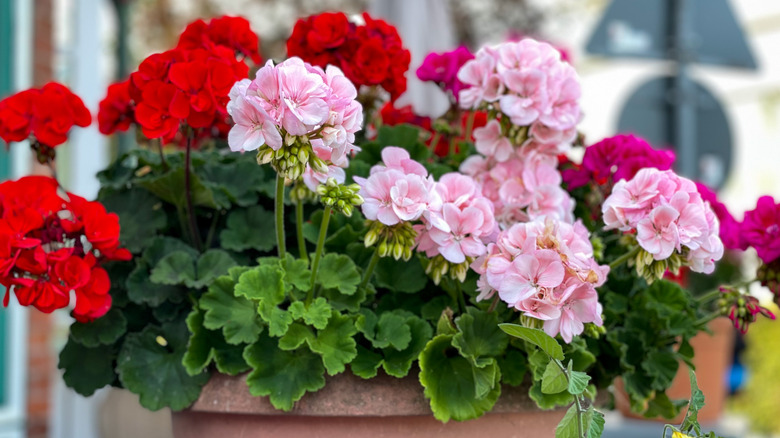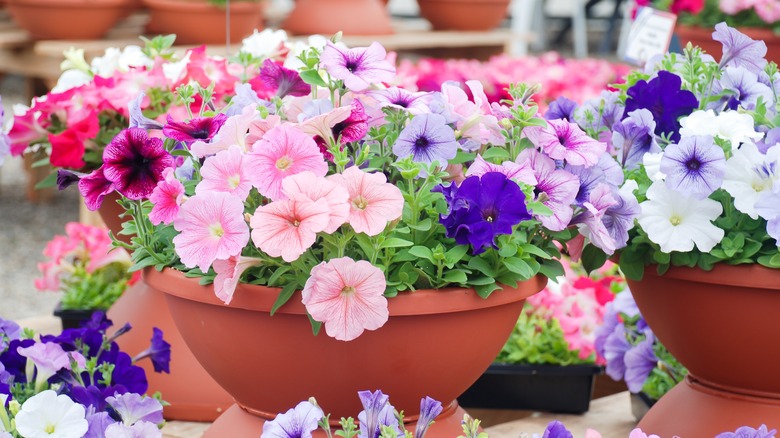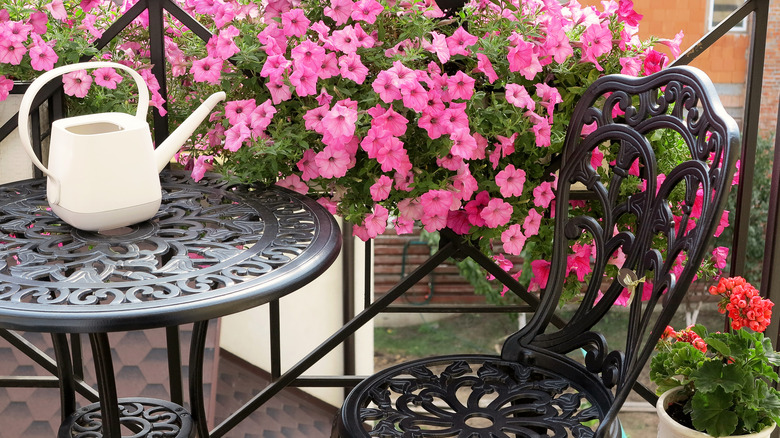The Stunning Flower You Should Plant Near Geraniums For Extra Color
Whether your garden is a big plot of land or a few pots on your back stoop, you can maximize the area with color and fragrance by planting geraniums. These popular flowers are easy to maintain and flexible, growing well either in the ground or a container. They just need several hours of full sun and regular watering to bloom from spring until the weather turns frosty. They come in a wide variety of colors from white to pale pink, salmon, and a dark, bold red. Some types have variegated flowers or leaves, which create additional visual interest in the garden. Because they're easy to grow, they are extremely popular and used as borders along walks or fences, as a complementary plant in hanging baskets and window boxes, or as a bright spot alongside vegetable gardens, particularly next to tomatoes and peppers.
For true eye-popping impact, consider adding another plant next to your geraniums — one that loves the same type of growing conditions, and one that comes in even more colors than geraniums do. It's petunias. These showy, trumpet-shaped flowers will bloom next to your geraniums all summer long for show-stopping color throughout the season. Petunias are also easy to grow and thrive whether planted in the ground or containers. So get ready to plant a boatload of color that will enhance your garden with little maintenance on your part.
Large, medium, and small
Not only are there hundreds of varieties of petunias, but they come in several sizes. Grandiflora are the largest, with blooms three to four inches across. Multiflora have many, many blooms but are somewhat smaller. Milliflora are mini-petunias with small flowers only an inch or so across. Some types spread quickly, meant to cover blank spaces in the garden or along a wall quickly. All of these varieties need plenty of light — five or six hours worth. Those that get too much shade create fewer blossoms. As you can imagine, a plant that uses up most of its energy in sprouting blossoms needs regular watering. Petunia and geraniums in hanging baskets need a bit more water than anything planted in the ground or in a container.
When it comes to watering, get into a routine. New plantings should be watered right away, and then every day for the first week or so. The best way to determine if your petunias (and geraniums) need to be watered is to feel the soil. If the soil feels dry, go ahead and water. Potted plants need great drainage, and often dry out faster than plants in the ground. Again, test the soil with your fingertips, The soil should be slightly damp — not dry and not soaking wet. Potted petunias may need to be watered every few days, depending on your climate.
Keep plants fresh and colorful
Besides proper watering, the best way to ensure your petunias maintain a fresh look throughout the growing season is to take the time to deadhead the spent blossoms. But be sure to take the entire stem from the plant, not just the faded petals.
Once your plants are established in the garden or their respective pot, sit back and enjoy the cascade of blossoms for the coming months. Let your imagination go crazy with color combinations. Petunias come in hundreds of shades, some with a ruffle, some with a double ruffle, and some variegated, two-toned, or with a dramatic border. Some have the color start as a dark tone inside the trumpet of the flower, and then lighten as the flower blossoms outwards. Petunias come in dozens of shades of pink and purple, yellow, white, striped, and even polka-dotted. Your local garden center should have a wide assortment to choose from, and if you have your heart set on a particular color or style, many professional nurseries offer plants online.


